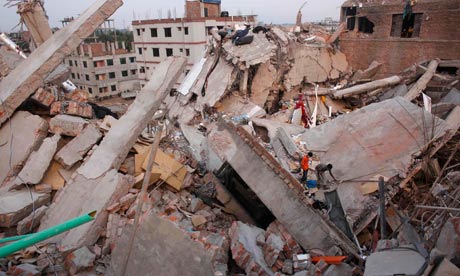Survey conducted in wake of Rana Plaza factory collapse reveals three-fifths of such buildings are cause for concern

The Rana Plaza building collapse, which killed more than 1,100 people, sparked global outrage. Photograph: Andrew Biraj/Reuters
Three-fifths of garment factories in Bangladesh are vulnerable to collapse, according to a survey by engineers in the country.
Last month concrete pillars supporting the eight-storey Rana Plaza building on the outskirts of the capital, Dhaka, gave way. More than 1,100 people, mainly young women making clothes for UK retailers such as Primark were killed in one of the world's worst industrial accidents.
The survey's revelation that the lives of millions of Bangladeshi workers, often making goods for western firms, are at risk will concern western retailers which, following global outrage after the Rana Plaza collapse, are now moving to improve security and conditions in the Bangladesh factories that supply their shops. Bangladesh is the world's second biggest supplier of clothes. More than 80% are exported to Europe or the US. The £13bn industry employs about 3.5 million people, mainly young women, and is a major foreign currency earner for Bangladesh.
The survey is the work of a team of engineers from the Bangladesh University of Engineering and Technology (BUET). They have so far surveyed a sixth of 600 buildings that house more than 3,000 clothes factories.
"Somewhere around 60% of the buildings are vulnerable," said Prof Mehedi Ansary, who leads the team. "This doesn't mean they will collapse in the next week or month, but it does mean that to leave them unchanged would be irresponsible."
Managers ignored warning signs such as cracks, which appeared in the days before the Rana Plaza collapse on 24 April in the Dhaka suburb of Savar. Workers said they were told there was no cause for worry and they should get back to work.
The BUET team is conducting a visual survey of buildings housing workshops, as well as examining soil tests and original plans. Although there are more than 3,000 active factories, permits have been given for more than 5,000. Many, particularly those in the centre of Dhaka, are in buildings that have been converted from residences or offices.
According to the police report into the Rana Plaza collapse, permission was given in 2006 for a five-storey building. This was correctly designed and constructed, according to Ansary, who has examined the plans. But three more floors were later added, with documents falsified to obtain permission from local authorities, he said. This extension overloaded the structure.
Its owner, Sohel Rana, has been charged over the collapse. Investigations have suggested that he abused his influence as a local boss of the ruling Awami League party to divert the authorities' attention.
The immediate trigger for the collapse appears to have been vibrations caused by generators, which provided electricity during frequent power cuts.
The factories in buildings not intended for industrial purposes, both in Dhaka and Bangladesh's second city of Chittagong, are of most concern. Many were set up without any regulatory oversight in the early years of the garment industry boom.
Ansary said that "there may be lots of very vulnerable [factories] we don't know about" but the team "did not want to create panic so we are saying they can run for the moment".
Two different agreements among western firms such as Primark, Walmart, Carrefour, H&M, Gap, Tesco and other are household names are being negotiated to improve working conditions. These would theoretically commit retailers to taking measures that would prevent another tragedy, as well as providing funds for improvements.
The Bangladesh Garment Makers and Exporters Association (BGMEA) has also implemented further measures. The Ansary-led survey follows a new demand by BGMEA to its members to provide it with building plans and soil tests to show the structural strength of their factories.
"It is a very hard time. We have to learn the lessons from Rana Plaza and Tasreen [a factory which burned down killing 114 last year]," said Atiqul Islam, president of the association.
Islam said 75% of BGMEA member had now submitted plans for their factories for inspection, but making all existing workshops safe was a "massive job".
Fire safety also remains a major problem. There have been a series of lethal fires in factories in Dhaka in recent years.
Last weekend, the Guardian visited a five-storey factory where more than 400 workers in tightly packed lines stitched and packed fleece winter jackets for sale in Europe. A single narrow stairwell was obstructed by piled cardboard boxes, windows were barred and an external fire exit had been removed. On the first floor an industrial boiler was separated from piles of card and clothes by a thin partition wall.
The manufacturers complain of "massive pressure" from buyers to keep prices low.
"Every year our cost of production is rising. Land, utilities, salaries, everything is going up. But the price of apparel is going down, It's a sick industry now," said Islam.
Workers typically earn a basic wage of around 5,000 takas (£40) a month, but can often make more with overtime. A new wage commission is likely to lead to an increase, as well as better conditions.
Some activists believe the tragedy may have prompted genuine change. "This is a historic turning point," said Kalpona Akter, of the Bangladesh Centre for Workers' Solidarity.